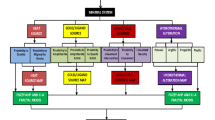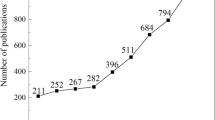Abstract
The correct evaluation of failure hazard in water and gas supply pipelines has been a great problem in areas which are subject to considerable surface movements. The complexity of elements from which pipeline network consists allows only for an approximated evaluation of their resistance. It is practically impossible to precisely determine the places of failures, and therefore attempts were made in the paper to construe a fuzzy system of evaluation of water supply network hazard which would be integrated with the geographic information system (GIS). The uncertainty factor was to be accounted for in the system through the use of linguistic variables, e.g., resistance of water pipeline and hazard of the terrain in the form of fuzzy sets. The reasoning was based on a Mamdani-type fuzzy model. The inferences of variables relating to the resistance of the pipeline supply network and hazards generated by continuous surface strains could be integrated in the presented fuzzy model. The ultimately scaled model was integrated with the geographic information system. The model was presented on the example of hazard evaluation of water supply network located in a mining area.












Similar content being viewed by others
References
Batzias FA, Siontorou CG, Spanidis PMP (2011) Designing a reliable leak bio-detection system for natural gas pipelines. J Hazard Mater 186:35–58
Busch W, Maas K, Fugmann J (2006) Anmerkungen zur Risikoanalyse bei altbergbaulichen Schadensprognosen. Altebergbau-Kolloquium, Aachen
Chen Y, Niu Z, Bai J, Wang Y (2014) Seismic vulnerability assessment of water supply network in. Tianjin, China. Front Environ Sci Eng 8(5):767–775. doi:10.1007/s11783-014-0632-6
Geertsema M, Schwab JW, Blais-Stevens A, Sakals ME (2009) Landslides impacting linear infrastructure in west central British Columbia. Nat Hazards 48(1):59–72
Gheorghe AV, Mrock R, Kröger W (2000) Risk assessment of region al systems. Reliab Eng Syst Saf 70:141–156
Ioannidou IA, Paraske Vopoulos S, Tzionas P (2003) Fuzzy modeling of Interactions among Environmental Stressors in the Ecosystem of Lake Koronia, Greece. Environ Manag 32(5):624–638 Springer, New York
Kalisz P (2007) The impact of mining on the water pipelines reliability. Sci Pap Silesian Univ Technol 278:191–200 (in Polish)
Knothe S (1953) Equation of the final profile of subsidence. Archives of Mining and Metallurgy, t.1, z.1, Warszawa (in Polish)
Kowalski A, Kwiatek J (1995) Terrain surface and buildings protection endangered by underground mining. Przegląd Górniczy, vol 4 (in Polish)
Kunert HG, Otegui JL, Marquez A (2012) Nonlinear FEM strategies for modeling pipe–soil interaction. Eng Fail Anal 24:46–56
Kwiatek J, Mokrosz R (1996) Gas networks in mining areas. WUG, vol 3 (in Polish)
Laurentysa CA, Bomfimb CHM, Menezesa BR, Caminhasa WM (2011) Design of a pipeline leakage detection using expert system: a novel approach. Appl Soft Comput 11:1057–1066
Lee S (2007) Application and verification of fuzzy algebraic operators to landslide susceptibility mapping. Environ Geol 52(4), Berlin
Liu PF, Zheng JY, Zhang BJ, Shi P (2010) Failure analysis of natural gas buried X65 steel pipeline under deflection load using finite element method. Mater Des 31(3):1384–1391
Liu X, Liu J, Guo S (2011) GIS-based fuzzy comprehensive evaluation on underground gas pipeline risk. In: ICEES 2011, Singapore, 14–16 October 2011
Liu R, Xiong H, Wu X, Yan S (2014) Numerical studies on global buckling of subsea pipelines. Ocean Eng 78:62–72
Liu X, Zhang J, Tong Z (2015) Modeling the early warning of grassland fire risk based on fuzzy logic in Xilingol, Inner Mongolia. Nat Hazards 75(3):2331–2342
Malinowska A (2011) A fuzzy inference-based approach for building damage risk assessment on mining terrains. Eng Struct 33(1):163–170
Malinowska AA (2016) Reliability of methods used for pipeline hazard evaluation in view of potential risk factors. Nat Hazards 83:715–728. doi:10.1007/s11069-016-2348-3
Malinowska A, Hejmanowski R, Rusek J (2014) Model of damage risk assessment of buildings and infrastructure due to surface deformation and decision support algorithm in terms of preserving public safety. Report of the research Grant No. 2011/01/D/ST10/06958 (in Polish, unpublished material)
Markowski AS, Mannan SM (2009) Fuzzy logic for piping risk assessment (pfLOPA). J Loss Prev Process Ind 22:921–927
Mendec J, Kliszczewicz B, Wytrychowska M (1997) The terrain surface and the buildings protection against mining damages. Rules for the protection of water supply and sewerage against the influence of underground mining. Wyd. GiG, Katowice (in Polish)
Mousavi M, Hesari M, Azarbakht A (2014) Seismic risk assessment of the 3rd Azerbaijan gas pipeline in Iran. Nat Hazards 74(3):1327–1348
Popiołek E, Ostrowski J, Stoch T (1997) Random dispersion of the distribution of area surface deformation indexes in contemporary conditions of mining exploitation in Poland. IV Dni Miernictwa Górniczego i Ochrony Terenów Górniczych: materiały z konferencji naukowo-technicznej: Rytro, 24–27 września 1997 r. pp 147–154 (In Polish)
Pourghasemi HR, Pradhan B, Gokceoglu C (2012) Application of fuzzy logic and analytical hierarchy process (AHP) to landslide susceptibility mapping at Haraz watershed, Iran. Nat Hazards 63(2):965–996
Przybyła H, Świądrowski W (1968) Determination of resistance category of existing public housing the influence of mining. Protection of Mining Areas
Shahriar A, Sadiq R, Tesfamariam S (2012) Risk analysis for oil & gas pipelines: a sustainability assessment approach using fuzzy based bow-tie analysis. J Loss Prev Process Ind 25:505–523
Simranpreet SG, Jagdev S (2013) Artificial intelligent modeling to predict tensile strength of inertia friction-welded pipe joints. Int J Adv Manuf Technol 69:2001–2009. doi:10.1007/s00170-013-5177-5
Talesnick M, Baker R (2008) Failure of flexible pipe with a concrete liner. Eng Fail Anal 5(3):247–259
Tavana M, Sodenkamp MA, Pirdashti M (2010) A fuzzy opportunity and threat aggregation approach in multicriteria decision analysis. Fuzzy Optim Decis Making 9:455–492
Xie Z, Du Q, Ren F, Zhang X, Jamiesone S (2015) Improving the forecast precision of river stage spatial and temporal distribution using drain pipeline knowledge coupled with BP artificial neural networks: a case study of Panlong River, Kunming, China. Nat Hazards 77(2):1081–1102
Xingquan L, Jingjing L, Shanshan G (2011) GIS-based fuzzy comprehensive evaluation on underground gas pipeline risk. Energy Procedia 11:3911–3917
Yuhua D, Datao Y (2004) Estimation of failure probability of oil and gas transmission pipelines by fuzzy fault tree analysis. J Loss Prev Process Ind 18:83–88
Zadeh LA (1965) Fuzzysets. Inf Control 38(1):1–14
Zhao W, Nassar R, Hall D (2005) Design and reliability of pipeline rehabilitation liners. Tunn Undergr Sp Technol 20:203–212
Acknowledgments
The research reporter in this paper has been supported by a grant from the National Science Centre No. 2011/01/D/ST10/06958.
Author information
Authors and Affiliations
Corresponding author
Rights and permissions
About this article
Cite this article
Malinowska, A.A. Fuzzy inference-based approach to the mining-induced pipeline failure estimation. Nat Hazards 85, 621–636 (2017). https://doi.org/10.1007/s11069-016-2594-4
Received:
Accepted:
Published:
Issue Date:
DOI: https://doi.org/10.1007/s11069-016-2594-4




